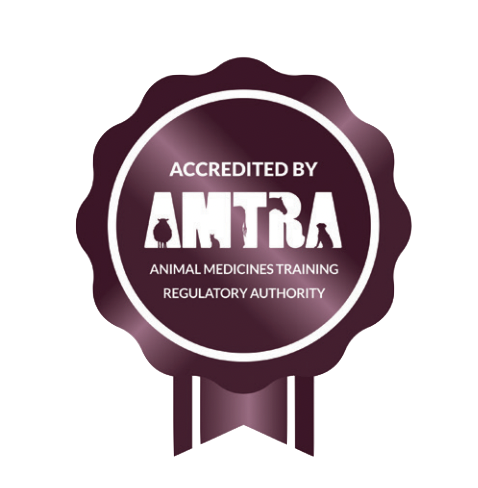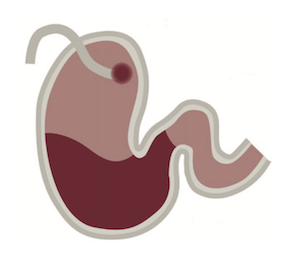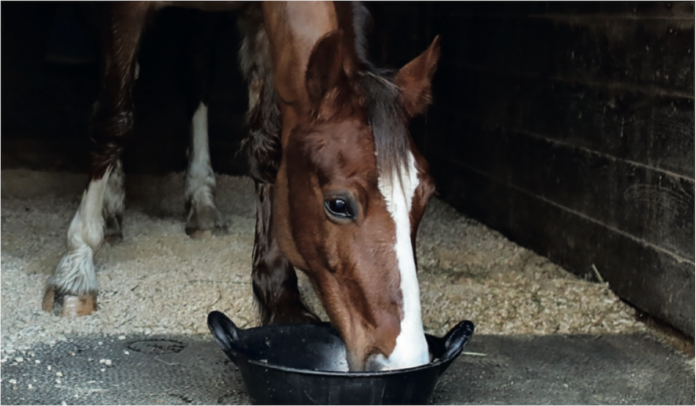EQUINE GASTRIC ULCER SYNDROME

By Lizzie Drury MSC RNUTR, senior nutritionist at Saracen Horse Feeds
AMTRA is required by the Veterinary Medicines Regulations to ensure its RAMAs/SQPs undertake CPD. All RAMAs/SQPs must earn a certain number of CPD points in a given period of time in order to retain their qualification. RAMAs/SQPs who read this feature and submit correct answers to the questions below will receive two CPD points. For more about AMTRA and becoming a RAMA/SQP, visit www.amtra.org.uk
Horses evolved to ingest a high fibre, low starch ration on an almost continual basis. Foraging behaviour is important to the maintenance of a healthy digestive tract, as not only does the flow of forage through the digestive system ensure optimal digestive health but the chewing process produces large amounts of saliva, which helps to buffer the acid that is produced in the stomach.
The way in which we keep and manage horses often means that they are unable to exhibit this normal foraging behaviour and are exposed to high stress levels such as during training or early weaning, as well as being fed rations that may have high cereal and starch levels with less than optimal forage and fibre allowance catered for. These feeding and management practices have been associated with a high prevalence of Equine Gastric Ulcer Syndrome (EGUS).
EGUS is a term that is used to describe ulcers in the terminal oesophagus, non glandular and glandular regions of the stomach and the proximal duodenum. It was thought to more commonly affect Thoroughbred racehorses, but with the advancement of research and increased ability to be able to study other classes of horses, EGUS has significant prevalence in other classifications of performance horses e.g. show horses, eventers, dressage and endurance horses. The common factor amongst these horses is that they are more likely to have reduced turnout, receive a lower forage intake and are exposed to higher stress levels due to more frequent travel and competition, and are therefore also more likely to have irregular feeding patterns.
However, it is also becoming more apparent that EGUS can also affect leisure horses and we are certainly now dealing with far more ‘leisure’ cases via our feed helpline. It has also been seen that all ages and breeds of horses and ponies are susceptible to EGUS.

Ulcers have been identified throughout the stomach and the most commonly affected area is the non-glandular squamous mucosa along the margo plicatus. Lesions that occur in the squamous area of the stomach are usually a result of prolonged exposure, or ‘splash’, from hydrochloric acid, to a poorly protected area of the stomach.
Prevalence of glandular mucosal lesions is certainly increasing as expertise in the use of the endoscope rises and the lower part of the stomach is investigated more thoroughly. Glandular lesions are thought to result from impaired mucosal defence mechanisms rather than a primary peptic or acid injury. This is supported by the observation that feed deprivation models used to create squamous injury do not produce glandular lesions.
Glandular lesions can be successfully induced in horses using excessive administration of non-steroidal anti- inflammatory drugs, and there is increasing evidence of a bacterial component to glandular ulcer development.
It has been suggested that EGUS should be divided into three distinct types
- Primary squamous ulceration – resulting as an increase in acid exposure
- Primary glandular ulceration – resulting as a failure of the mucosal defences
- Pyloric ulceration - caused by bile reflux
RISK FACTORS
Pasture turnout
- In general, grazing horses appear to have a reduced prevalence of EGUS. Horses that are allowed to be horses will trickle feed and freely exhibit their natural feeding behaviour, therefore chewing frequently allowing for the copious production of saliva to buffer the continual acid production in the stomach.
Forage Feeding
- When fed hay and pasture, horses produced 400 - 480 grams of saliva per 100 grams of dry matter consumed, whereas when a concentrate feed was fed, horses produced half as much saliva, therefore significantly reducing the buffering capacity.
- Alfalfa increases the buffering potential due to its higher calcium concentration.
- If straw is fed as the sole forage source, an increase in gastric lesions has been observed possibly due to low protein and calcium content, and the coarse nature of the straw may increase gastric irritation.
Starch Intake
- Cereal and starch intake has been associated with an increased risk of EGUS in horses. Exceeding 2g/Kg bodyweight (BW) of starch intake per day was associated with a two-fold increase in the likelihood of EGUS and feeding more than 1g/Kg BW of starch per meal was associated with a 2.6 fold increase in the likelihood of EGUS.
Fasting
- Horses evolved to trickle feed and therefore almost continuously eat and chew and produce continual but varying amounts of gastric acid. Chewing produces saliva, an important buffer of stomach acid. Withholding feed, even if for a short time, causes a rapid drop in gastric pH.
- Gastric ulceration can be induced by alternating 24-hour periods of feed deprivation and ad-libitum access to hay for a total of 96 hours of feed deprivation. Feed deprivation reduces the amount of saliva production and feed ‘matting’ to protect the squamous mucosa.
Exercise
- Workload has been suggested to be one of the most important risk factors for EGUS. It is suggested that contraction of the stomach during exercise allows acid from the glandular mucosa to reflux up into the non-glandular region of the stomach resulting in acid injury to a relatively unprotected mucosal lining. Less marked injury has been seen in horses that have been fed prior to exercise.
Age, Breed, Gender
- Some studies have shown an increase of EGUS in younger horses, aged two to six years, although this was confined to racehorses, while other studies have shown that the risk increases as age increases. A study in leisure horses showed no association between age, breed and gender.
Other Risk Factors
- Water deprivation
- Electrolyte administration
- Administration of NSAIDS
- Reflux of bile acids
- Bacterial contamination
CLINICAL SIGNS
The clinical signs of EGUS can vary from horse to horse and can also be a reflection on that individual horse’s temperament. Some horses will show more outwardly obvious signs with mild ulceration while others may show limited signs even in the presence of substantial ulceration. Personal observation has shown that horses with glandular lesions tend to have less tolerance to glandular ulcers than squamous ulcers.
Typical signs include:
• Poor appetite or change in eating behaviour
• Weight loss or failure to thrive
• Irritability and general changes in temperament
• Reduced performance
• Abdominal discomfort to girthing or grooming
• Recurrent mild colic
DIAGNOSIS
The only reliable method of diagnosis is by use of the endoscope. For this procedure to be carried out successfully feed needs to be withheld for 12 hours to allow for sufficient gastric emptying. A scoring system is
used to score the lesions according to the number of lesions and their severity.
MEDICAL TREATMENT
Your vet is the best person to discuss treatment protocols with, but generally the treatment involves the use of medications such as Omeprazole and coating or binding agents to help protect the stomach lining.
NUTRITIONAL MANAGEMENT TO REDUCE THE RISK OF EGUS
- Horses should ideally be allowed ad-lib access to long forage or fed at least no less than 1.0Kg/100Kg BW.
- Good doers or horses that are resting or in light work may benefit from a reduced DE content forage source or a low-calorie forage replacer. Straw can be used to dilute the hay or haylage ration but should not exceed more than 25% of the forage ration.
- Restrict cereal and starch intake and ideally feed less than 2g/Kg BW starch per day and less than 1g/Kg BW per meal.
- Consider adding some alfalfa chaff to horses’ feed to increase the buffering potential of the ration. 100-200 grams/ 100Kg BW is suitable.
- If the DE requirement is high to maintain work rate or body condition, introduce some vegetable oil e.g. maize oil to the ration at a rate of up to 100ml / 100Kg BW or use a high fat, rice bran supplement.
- When adding additional liquid oil to the ration, make sure that you check the antioxidant status of the ration e.g. Vitamin E.
- Provide as much pasture turnout as is practically possible
- Provide constant access to water.
- Look at ways of helping to reduce stress levels.
- Consider using antacid supplements to help protect the digestive system from gastric lesions.

ABOUT ETN’S RAMA/SQP FEATURES
ETN’s series of CPD features helps RAMAs (Registered Animal Medicines Advisors/SQPs) earn the CPD (continuing professional development) points they need. The features are accredited by AMTRA, and highlight some of the most important subject areas for RAMAs/ SQPs specialising in equine and companion animal medicine.
AMTRA is required by the Veterinary Medicines Regulations to ensure its RAMAs/SQPs undertake CPD. All RAMAs/SQPs must earn a certain number of CPD points in a given period of time in order to retain their qualification. RAMAs/SQPs who read this feature and submit correct answers to the questions below will receive two CPD points. For more about AMTRA and becoming a RAMA/SQP, visit www.amtra.org.uk











